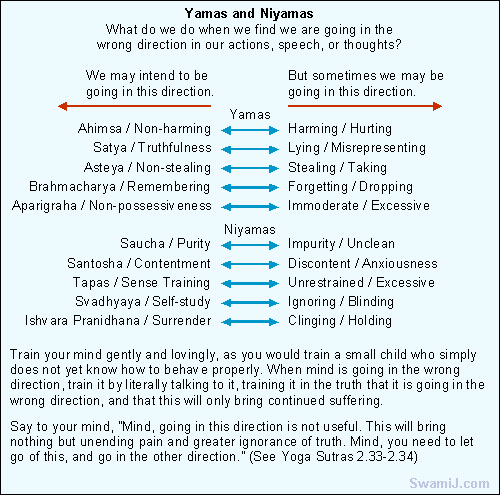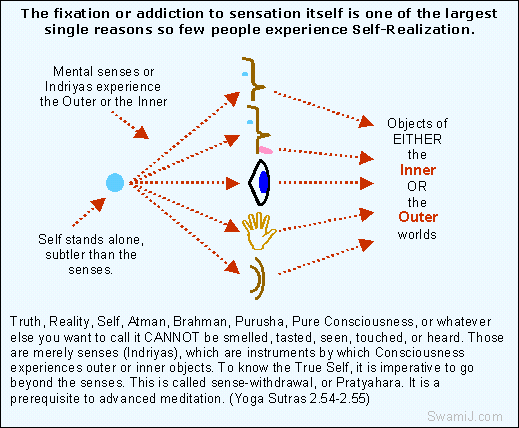|
|
Yoga
Sutras 2.26-2.29:
The 8 rungs
of Yoga
are for Discrimination
(Previous
Next Main)
 The eight rungs or limbs:
The art and science of Yoga is systematically described in eight (ashta) rungs, steps, or limbs
(anga). Thus, this section of the Yoga Sutras is also called
Ashtanga Yoga. The eight rungs of Yoga are summarized in sutra 2.29,
and explained in the next section (2.30-2.34). Subsequent
sutras further describe the benefits and methods of working with those
eight rungs (2.35-2.45,
2.46-2.48,
2.49-2.53,
2.54-2.55).
The
links below will take you directly to the descriptions of each of the eight rungs: The eight rungs or limbs:
The art and science of Yoga is systematically described in eight (ashta) rungs, steps, or limbs
(anga). Thus, this section of the Yoga Sutras is also called
Ashtanga Yoga. The eight rungs of Yoga are summarized in sutra 2.29,
and explained in the next section (2.30-2.34). Subsequent
sutras further describe the benefits and methods of working with those
eight rungs (2.35-2.45,
2.46-2.48,
2.49-2.53,
2.54-2.55).
The
links below will take you directly to the descriptions of each of the eight rungs:
- Yama: codes of
restraint, abstinences (2.30,
2.31)
- Niyama:
observances, self-training (2.32)
- Asana: meditation
posture (2.46-2.48)
- Pranayama: expansion of
breath and prana (2.49-2.53)
- Pratyahara: withdrawal
of the senses (2.54-2.55)
- Dharana: concentration
(3.1)
- Dhyana: meditation
(3.2)
- Samadhi: deep absorption (3.3)
The 8 rungs are for discriminative
enlightenment:
The reason for practicing the eight rungs of Yoga (2.29) is to develop attention as
the tool for discriminative knowledge, which is the means to
discriminative enlightenment and liberation. It means using razor-like attention (3.4-3.6)
to
separate the seer and the seen (2.17), so as to break the alliance of karma (2.12-2.25),
and to get past the four mistakes of ignorance, or avidya (2.24-2.25),
which are: 1) confusing the temporary for the eternal, 2) the impure for the
pure, 3) misery for happiness, and 4) the false self for the true Self (2.5). Resulting
from this systematic discrimination, the seer or Self is eventually
experienced in its true nature (1.3).
Discerning three aspects of an object:
To understand the principle of discernment presented in these current sutras it
is critically important to recall and understand the three aspects of an object
described in Sutra 1.42, which have to
do with the name of the object, the specific object, and the underlying essence.
Discrimination allows subtler
introspection: This one-pointed attention and discrimination, which comes from the practice of the eight
rungs, is used for examining, exploring, and attenuating the colorings of
the subtle impressions of the mind field (2.10),
so as to go beyond, inward to the pure, eternal center of
consciousness.
The first 5 rungs sharpen the razor:
If it is razor-like attention that is the
tool for discrimination, then it is the first five rungs of the Yoga
Sutras which are honing the edge of that razor. Then, the finer, sharpened
tool is the last three rungs, which are concentration, meditation, and
samadhi, which are collectively called samyama (3.4).
See also the article:
Coordinating the Four Functions of Mind
top
2.26
Clear, distinct, unimpaired discriminative knowledge is the means of
liberation from this alliance.
(viveka khyatih aviplava hana upayah)
- viveka-khyatih =
discriminative knowledge (viveka = discriminative, discernment;
khyatih = knowledge, correct cognition, clarity, awareness)
- aviplava = undisturbed,
without vacillation, uninterrupted
- hana = of removal, of
avoidance
- upayah = the means, way,
method
Removing avidya or ignorance: The
last section dealt with the process of breaking the alliance of karma (2.12-2.25),
particularly through causing an absence of ignorance (avidya) (2.24,
2.25), which is of four major forms
(2.5): 1) regarding that which is
transient as eternal, 2) mistaking the impure for pure, 3) thinking that
which brings misery to bring happiness, and 4) taking that which is
not-self to be self.
Discriminative knowledge is the means:
Here, in this current sutra, discriminative knowledge is introduced as the
key to liberation from this alliance to ignorance (avidya).
Discriminative
knowledge is the key to the entire science of Yoga (Here, the
term "knowledge" does not mean mere intellectual knowledge. Rather, it
refers to the higher insight of direct experience). Through
discrimination, one gradually, systematically separates the seer
from the seen (2.17, 2.12-2.25),
until the final realization of the true, eternal Self dawns (1.3,
4.22-4.26).

What is discrimination?:
Discrimination is a process of sorting out between this and that.
This sorting out process may begin at the most external level of our
relationship with the world, such as in practicing principles such as
non-injury or truthfulness (2.34).
It may include purifying the gross colorings of the mind (2.1-2.9),
or the more subtle colorings (2.10-2.11).
Over and over, this razor sharp discrimination (3.4-3.6)
cuts ever deeper into the levels of false identities (1.5)
habitually clouding the true Self (1.4).
Discriminative enlightenment:
Through the repeated process of attaining discriminative knowledge through
those many gross, subtle, and subtler levels of our being (1.17),
comes discriminative enlightenment (4.22-4.26).
It is an ongoing process of discriminating between Self and non-Self,
until the Self is seen to stand alone (1.3).
See also the article:
Coordinating the Four Functions of Mind

top
2.27
Seven kinds of ultimate insight come to one who has attained this degree
of discrimination.
(tasya saptadha pranta bhumih prajna)
- tasya = to one, to such
a person
- saptadha = sevenfold
- pranta = final, ultimate
- bhumih = stage, level,
degree
- prajna = discrimination,
insight, wisdom, cognizing consciousness
Many insights are revealed: As
that discriminative knowledge unfolds (2.26), there is
a tremendous amount of insight or wisdom that comes. Though it is not
realistic to count them all, Patanjali states that seven types of ultimate
insight come as a result of the intense practice of discrimination through
the rungs of Yoga (3.4-3.6).
Seven types of insight: The
commentator Vyasa describes these seven insights briefly. It is important
to understand that the insights are meant to be indicative of the final
stages of discriminative knowledge, not that these are to serve as a
checklist, or goals of powers to attain. These seven are a reflection of
the consequences from the whole process of Yoga described in the Yoga
Sutras
- The deep inner sources of future
suffering, which would have played out as karma, have been identified,
and the mind is no longer drawn towards those thought patterns.
- The root causes or deep impressions
providing the potential for that karma to play out have been removed,
with nothing more needing to be done with them.
- Through the mastery (nirodhah) attained
by deep absorption (samadhi), the wisdom of realization has been
attained.
- Discrimination has brought sufficient
discriminative knowledge that nothing further remains about which to
inquire.
- Buddhi, the higher discriminative
aspect, has fulfilled its purpose and stands alone, with nothing more
to do.
- The activities of buddhi, no longer
needed, come to rest as a stone, which has rolled down a mountain,
having no need to arise again.
- Pure consciousness, Purusha, stands
alone, in its true, eternal Self.
top
2.28
Through the practice of the different limbs, or steps to Yoga, whereby
impurities are eliminated, there arises an illumination that culminates in
discriminative wisdom, or enlightenment.
(yoga anga anusthanad ashuddhi kshaye jnana diptih a viveka khyateh)
- yoga-anga = rungs of yoga
(yoga = yoga; anga = rungs, limbs, accessories, components, steps,
parts, members, constituents)
- anusthanad = by the
sustained practice, observance, performance
- ashuddhi =
impurities
- kshaye = with the
elimination, destruction
- jnana = of wisdom,
knowledge,
- diptih = light,
brilliance, shining, radiance
- a = until, up to
- viveka-khyatih =
discriminative knowledge (viveka = discriminative, discernment;
khyatih = knowledge, correct cognition, clarity, awareness)
Reason for the 8 rungs or limbs:
The reason for practicing the eight rungs or limbs of Yoga (2.29)
is to develop attention as the tool for
discriminative knowledge (viveka-khyatih), which is the means
to liberation or enlightenment.
Discriminative enlightenment:
Discrimination (viveka) means using razor-like attention (3.4-3.6)
to separate the seer and the seen (2.17),
so as to break the alliance of karma (2.12-2.25),
and to get past the four mistakes of ignorance, or avidya (2.24-2.25),
which are confusing the temporary for the eternal, the impure for the
pure, misery for happiness, and the false self for the true Self (2.5). Through
that discriminative knowledge comes discriminative enlightenment (4.22-4.26).
top
2.29
The eight rungs, limbs, or steps of Yoga are the codes of self-regulation or
restraint (yamas), observances or practices of self-training (niyamas),
postures (asana), expansion of breath and prana (pranayama), withdrawal of
the senses (pratyahara), concentration (dharana), meditation (dhyana), and
perfected concentration (samadhi).
(yama niyama asana pranayama pratyahara dharana dhyana samadhi ashtau
angani)
- yama = codes of
restraint, abstinences, self-regulations
- niyama = observances,
practices, self-training
- asana = meditation
posture (from the root ~as, which means "to sit")
- pranayama = expansion of
breath and prana, regulation, control
- pratyahara = withdrawal
of the indriyas (the senses), bringing inward
- dharana = concentration
- dhyana = meditation
- samadhi = meditation in
its higher state, deep absorption of meditation, the state of
perfected concentration
- ashtau = eight
- angani = rungs, limbs,
accessories, components, steps, parts, members, constituents
Steps versus rungs: The science of
Yoga, as described in the Yoga Sutra is also called Ashtanga Yoga. The word ashta means eight.
The word anga has two meanings; it means both rung and limb.
As rungs, it means that the eight rungs are done sequentially, like
climbing the steps of a ladder, wherein you must do one before the other.
As limbs, it means that the eight limbs are like eight branches coming out
of the same level of the trunk of a tree, wherein you do the eight
simultaneously.
Practice as both steps and rungs: In practice, the eight
angas of Yoga are done both
sequentially and simultaneously. Advancing with one rung helps with the next,
while at the same time, all of the limbs are practiced within ones current
capacity.
(It is important to note that the phrase Ashtanga
Yoga has recently become known as a system of physical postures, which
was never the ancient intent of this name.)
The eight rungs or limbs: The
eight rungs or limbs are each described in separate sutras through the
links provided below:
- Yama: codes of
restraint, abstinences, self-regulations (2.30,
2.31)
- Niyama: observances,
practices, self-training (2.32)
- Asana: meditation
posture (from the root ~as, which means "to sit") (2.46-2.48)
- Pranayama: expansion of
breath and prana, regulation, control (2.49-2.53)
- Pratyahara: withdrawal
of the indriyas (the senses), bringing inward (2.54-2.55)
- Dharana: concentration
(3.1)
- Dhyana: meditation
(3.2)
- Samadhi: meditation in
its higher state, deep absorption of meditation, the state of
perfected concentration (3.3)

The
next sutra is 2.30
Home
Top
-------
This site is devoted to
presenting the ancient Self-Realization path of
the Tradition of the Himalayan masters in simple, understandable and
beneficial ways, while not compromising quality or depth. The goal of
our sadhana or practices is the highest
Joy that comes from the Realization in direct experience of the
center of consciousness, the Self, the Atman or Purusha, which is
one and the same with the Absolute Reality.
This Self-Realization comes through Yoga meditation of the Yoga
Sutras, the contemplative insight of Advaita Vedanta, and the
intense devotion of Samaya Sri Vidya Tantra, the three of which
complement one another like fingers on a hand.
We employ the classical approaches of Raja, Jnana, Karma, and Bhakti
Yoga, as well as Hatha, Kriya, Kundalini, Laya, Mantra, Nada, Siddha,
and Tantra Yoga. Meditation, contemplation, mantra and prayer
finally converge into a unified force directed towards the final
stage, piercing the pearl of wisdom called bindu, leading to the
Absolute.
|
|




